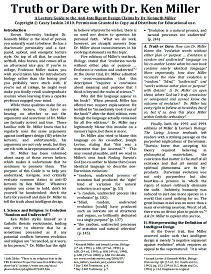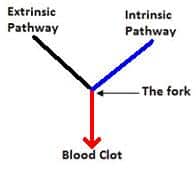 Life Sciences
Life Sciences
Misrepresenting Michael Behe’s Arguments for Irreducible Complexity of the Blood Clotting Cascade
 Download the Complete “Truth or Dare” with Dr. Ken Miller Lecture Guide Permission Granted to Copy and Distribute for Educational Use. Links to our 7-Part Series Responding to Ken Miller: • Part 1: Science and Religion: Is Evolution “Random and Undirected”? |
Another area where Ken Miller misrepresents irreducible complexity is the blood clotting cascade. With the flagellum, Miller took a shortcut by arguing that if a few parts can do something else, irreducible complexity is refuted. With the blood clotting cascade, Miller claims that if blood clotting works without parts that Behe doesn’t claim in Darwin’s Black Box are part of the irreducibly complex core of the system, then blood clotting isn’t irreducibly complex. Not only is Miller’s objection fallacious, it blatantly misrepresents Michael Behe’s arguments.
Roughly speaking, there are three “prongs” to the blood clotting cascade: two pathways which initiate the cascade (the extrinsic and intrinsic pathways) and the cascade itself, which forms the clot. These prongs are illustrated in the diagram below:

Simply put, in Darwin’s Black Box, Michael Behe makes it very clear that he only argues for irreducible complexity for the components after the “fork.” Thus Behe writes: “Leaving aside the system before the fork in the pathway, where some details are less well known, the blood-clotting system fits the definition of irreducible complexity.”39 Ken Miller’s response is to note that certain vertebrates–such as the puffer fish or certain cetaceans–lack components of the intrinsic pathway (such as blood clotting factors XI, XII, and XIIa), all of which are before the fork. Since Behe made it clear in Darwin’s Black Box that his argument for irreducible complexity only applied to components of the blood clotting cascade after the fork, it’s an open and shut case that Miller has not refuted Behe’s arguments. Behe made this clear at the Dover trial, stating:
The relative importance of the two [initiation] pathways in living organisms is still rather murky. Many experiments on blood clotting are hard to do. And I go on to explain why they must be murky. And then I continue on the next slide. Because of that uncertainty, I said, let’s, leaving aside the system before the fork in the pathway, where some details are less well-known, the blood clotting system fits the definition of irreducible complexity. And I noted that the components of the system beyond the fork in the pathway are fibrinogen, prothrombin, Stuart factor, and proaccelerin. So I was focusing on a particular part of the pathway, as I tried to make clear in Darwin’s Black Box. If we could go to the next slide. Those components that I was focusing on are down here at the lower parts of the pathway. And I also circled here, for illustration, the extrinsic pathway. It turns out that the pathway can be activated by either one of two directions. And so I concentrated on the parts that were close to the common point after the fork. So if you could, I think, advance one slide. If you concentrate on those components, a number of those components are ones which have been experimentally knocked out such as fibrinogen, prothrombin, and tissue factor. And if we go to the next slide, I have red arrows pointing to those components. And you see that they all fall in the area of the blood clotting cascade that I was specifically restricting my arguments to. And if you knock out those components, in fact, the blood clotting cascade is broken. So my discussion of irreducible complexity was, I tried to be precise, and my argument, my argument is experimentally supported.40
It’s this simple: Miller tested for irreducible complexity in components that Behe never argues are irreducibly complex, as he makes clear in Darwin’s Black Box. Miller blatantly misquotes Behe in Only a Theory on this point, misrepresenting Behe’s arguments as if they apply to the intrinsic pathway. For details on this matter, see:
| Truth or Dare: Why does Dr. Miller misrepresent Michael Behe’s arguments in Darwin’s Black Box as requiring that the intrinsic pathway is part of the irreducibly complex core of the blood clotting cascade? Why doesn’t Miller critique Behe’s actual arguments in Darwin’s Black Box rather than misrepresenting them? |
[Editor’s Note: Ken Miller speaks regularly on intelligent design (ID), and for years has repeatedly promoted the same misrepresentations of ID when speaking on the topic. This is Part 6 of a series of 7 posts that comprise a lecture guide for those listening to lectures by Dr. Miller against ID. When this series is complete, the entire lecture guide will be released as a single document.]
References Cited:
[39.] Darwin’s Black Box, p. 86 (1996).
[40.] Day 11 AM testimony, pp. 25-28.

